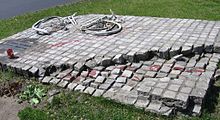Tiananmen Files

The Tiananmen File is a collection of classified documents allegedly drawn up by the Chinese government on the occasion of the Tiananmen Square massacre . Through an informant calling themselves Zhang Liang, they got to the sinologists Perry Link and Andrew J. Nathan, who published them in 2001. The reliability of the documents is controversial.
Content
Link and Nathan's book contains minutes of meetings, internal memoranda, meeting notes, and intelligence reports; each commented by the editors and accompanied by background information. Zhang Liang supplied the editors with around 600 documents as printouts of digital text documents, of which they translated around a third into English and - mostly abridged - included in their book. The texts cover the period from the death of Hu Yaobang , the cause of the conflict, to Deng Xiaoping 's congratulations to the People's Liberation Army on the occasion of the successful suppression of the uprising. The dispute of the party leadership about the type of procedure can be followed.
The documents contain few surprises and show the people involved as they were already known: Zhao Ziyang as progressive, Li Peng as hardliner, Deng Xiaoping as undecided. This gave rise to doubts about the authenticity of the documents. The elaborate style of language also appeared suspicious, but the editors assessed this as a result of post-processing by Chinese archivists. Errors were also discovered: In a conversation with Yang Shankun at the end of Mai, Deng Xiaoping incorrectly describes Xu Qinxian as the son of Xu Haidong. For Timothy Brook, the documents contain some dubious numbers and gaps, as well as passages that describe the events as they were from the point of view of the protesters, not those of the reporting soldiers.
In the foreword, the editors emphasize the coherence, abundance and human credibility that are almost impossible to falsify. The epilogue speaks of a relationship of trust between the editor and Zhang Liang that convinced them of the authenticity of the documents. Zhu Bangzao, spokesman for the Chinese Foreign Ministry, called the documents false and manipulative. Alfred L. Chan sees the Tiananmen files as a compilation of genuine (but only partially new) documents and texts constructed by embellishments and amalgamations by Zhang Liang.
literature
- Perry Link, Andrew J. Nathan (Eds.); Orville Schell (epilogue): The Tiananmen files (from the American by Ulrike Bischoff, Anton Manzella and Michael Schmidt), Propylaeen, Munich, 2001. ISBN 978-3-549-07134-2 . Original title: The Tiananmen Papers .
Individual evidence
- ↑ a b Richard Baum: Tiananmen - The Inside Story? . In: The China Journal No. 46, July 2001. pp. 119 ff.
- ↑ Timothy Brook: Review: The Tiananmen Papers . In: The Journal of Asian Studies No. 60/2, May 2001. pp. 540-545.
- ↑ Andrew J. Nathan: The Tiananmen Papers: An Editor's Reflections . In: The China Quarterly No. 167, September 2001. p. 731
- ^ Alfred L. Chan: Fabricated Secrets and Phantom Documents: the "Tiananmen Papers" and "China's Leadership Files," A Re-Rejoinder (PDF; 383 KiB). June 19, 2005